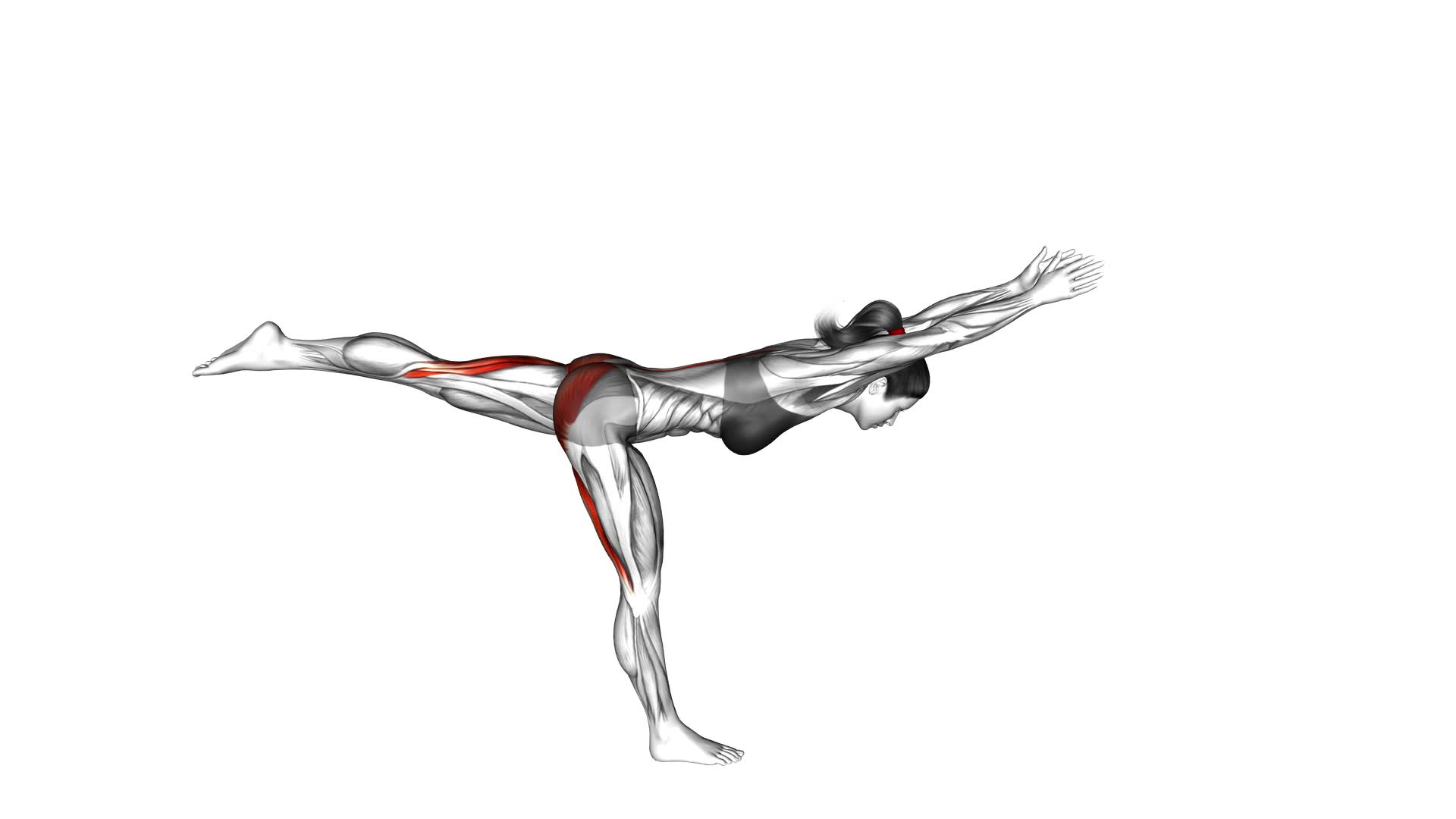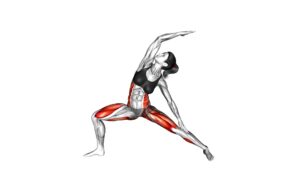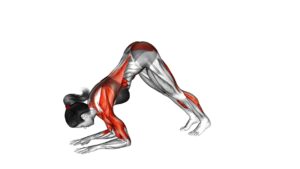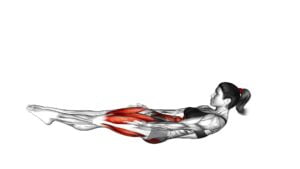Warrior III Pose (female) – Video Exercise Guide & Tips

Get ready to strengthen your body and improve your balance with Warrior III Pose.
Watch This Exercise Video
In this video exercise guide, you'll learn step-by-step how to master this powerful pose.
Discover the benefits of Warrior III, common mistakes to avoid, modifications for beginners, and tips for improving your balance.
Challenge yourself with variations to take your practice to the next level.
Get ready to feel strong, grounded, and centered in Warrior III Pose.
Let's begin!
Key Takeaways
- Warrior III Pose strengthens the legs, core stability, and enhances posture.
- Practicing Warrior III Pose improves focus and concentration.
- This pose increases flexibility by stretching the hamstrings, calves, and lower back.
- Proper alignment and balance techniques are essential to perform Warrior III Pose correctly.
Benefits of Warrior III Pose
To maximize the benefits of Warrior III Pose, focus on improving balance and strengthening your core muscles. This pose, also known as Virabhadrasana III, is a powerful standing balance pose that engages your entire body. By practicing Warrior III Pose, you can enhance your stability, increase your core strength, and improve your overall body awareness.
One of the key benefits of Warrior III Pose is the challenge it presents to your balance. As you extend one leg back and lean forward, you must engage your core muscles to maintain stability. This pose requires focus and concentration, helping to improve your body's proprioception. Additionally, practicing Warrior III Pose can enhance your overall coordination and help you develop a better sense of body control.
Modifications can be made to Warrior III Pose to suit your individual needs. If you struggle with balance, you can use a wall or a chair for support. Placing your hands on a stable surface can provide the necessary stability while allowing you to focus on strengthening your core muscles. Another modification is to use a block or bolster under your standing foot to provide additional support and stability.
Incorporating these tips and modifications into your practice of Warrior III Pose will help you maximize its benefits. Now, let's move on to the step-by-step guide to Warrior III Pose, where you'll learn the proper alignment and technique to perform this pose effectively.
Step-By-Step Guide to Warrior III Pose
To perform Warrior III Pose, start by standing tall with your feet hip-width apart.
Engage your core and lift one leg straight back behind you, while simultaneously lowering your torso towards the ground.
Keep your extended leg, arms, and torso in one straight line, and find a focal point to help with balance.
Remember to breathe and hold the pose for a few breaths before switching sides.
Alignment and Balance Techniques
Achieve optimal alignment and balance in Warrior III Pose by engaging your core, maintaining a straight spine, and grounding through your standing leg.
To ensure proper alignment, follow these techniques:
- Start in Mountain Pose, feet hip-width apart, arms by your sides.
- Shift your weight onto your right foot and engage your core.
- Extend your left leg behind you, keeping it parallel to the floor.
- Hinge forward at the hips, lifting your left leg higher.
- Reach your arms forward or extend them back alongside your body.
By aligning your body correctly and finding balance through your standing leg, you can fully experience the benefits of Warrior III Pose.
Now, let's move on to modifications for different abilities.
Modifications for Different Abilities
Now, let's explore modifications for different abilities in Warrior III Pose, building upon the alignment and balance techniques discussed earlier.
If you have difficulty maintaining balance or feel unstable in this pose, chair modifications can be helpful. Start by standing behind a chair with your feet hip-width apart. Place your hands on the back of the chair for support. Shift your weight onto your right leg and slowly lift your left leg behind you, keeping it straight and parallel to the floor. Engage your core and extend your torso forward, keeping your spine straight. Hold this position for a few breaths before switching sides.
Another option is to use props such as yoga blocks or a wall for added support and stability.
Benefits of Warrior III
To experience the numerous benefits of Warrior III Pose, focus on maintaining balance and alignment while engaging your core and extending your torso forward. This challenging yoga pose offers a range of benefits that can enhance your overall well-being.
Here are five key benefits of Warrior III:
- Strengthens your legs: Warrior III requires you to balance on one leg, which strengthens your quadriceps, hamstrings, and calves.
- Improves core stability: By engaging your core muscles to maintain balance, Warrior III helps to strengthen and stabilize your abdominal muscles.
- Enhances posture: This pose encourages proper alignment of the spine, helping to improve your posture over time.
- Boosts focus and concentration: The intense concentration required to hold Warrior III can enhance your mental focus and concentration.
- Increases flexibility: Warrior III stretches the entire back side of your body, including your hamstrings, calves, and lower back, improving overall flexibility.
Common Mistakes to Avoid in Warrior III Pose
Correcting common mistakes in Warrior III Pose is essential for maintaining proper form and maximizing the benefits of this challenging yoga pose.
When performing Warrior III, it's important to pay attention to your alignment and technique to avoid potential errors. One common mistake is allowing your standing leg to bend. To prevent this, engage your quadriceps and press firmly through the heel of your standing foot.
Another mistake is lifting the lifted leg too high, which can cause imbalance and strain. Instead, aim to keep your lifted leg in line with your torso, creating a straight line from head to heel.
Additionally, avoid collapsing your chest and rounding your back. Instead, maintain a long spine by drawing your navel towards your spine and extending your crown towards the front of the room.
Lastly, make sure to keep your hips level to avoid any twisting or tilting. Engage your core muscles and visualize your pelvis as a level surface.
Modifications for Beginners in Warrior III Pose
If you're a beginner, there are modifications you can make to ease into the Warrior III Pose and gradually build up your strength and balance. Here are some modifications you can try:
- Chair Modification: Stand facing a chair with your feet hip-width apart. Place your hands on the back of the chair for support. Slowly lift one leg behind you, keeping it straight and parallel to the floor. Try to maintain a straight line from your head to your lifted leg. Hold for a few breaths and then switch sides.
- Wall Modification: Stand facing a wall with your feet hip-width apart. Place your hands on the wall for support. Slowly lift one leg behind you, keeping it straight and parallel to the floor. Try to maintain a straight line from your head to your lifted leg. Hold for a few breaths and then switch sides.
- Use props: You can also use props such as blocks or blankets to help you maintain balance and stability in the pose.
- Take it step by step: Instead of lifting your leg all the way up, start by practicing with a smaller range of motion. Gradually work your way up to lifting your leg higher as you gain strength and stability.
- Engage your core: Focus on engaging your core muscles to help you maintain balance and stability in the pose.
Tips for Improving Balance in Warrior III Pose
To improve your balance in Warrior III Pose, focus on engaging your core muscles and maintaining a straight line from your head to your lifted leg. Improving focus and building core strength are key to mastering this challenging pose.
First, start by standing tall with your feet hip-width apart. Take a moment to ground yourself and find your center of balance. As you shift your weight onto one leg, lift the other leg off the ground and extend it straight behind you. Keep your standing leg slightly bent to avoid locking your knee.
Next, engage your core muscles by drawing your navel in towards your spine. This will help stabilize your body and maintain balance. Imagine a straight line extending from the crown of your head to your lifted leg. Keep your gaze focused on a point in front of you to help with stability and balance.
As you continue to hold the pose, breathe deeply and evenly. This will help you stay centered and focused. If you find it challenging to maintain your balance, you can use a wall or a chair for support. Gradually, as you build strength and stability, you can practice the pose without any external support.
Variations to Challenge Your Practice in Warrior III Pose
To challenge your practice in Warrior III Pose, there are several variations that you can try.
One way to challenge your balance is by closing your eyes while in the pose, which will require you to rely solely on your proprioception.
Another option is to add a twist to the pose by bringing one hand to the opposite knee, which will engage your core and challenge your stability.
Additionally, you can try lifting one leg higher or extending the arms forward to further strengthen and challenge your body in this pose.
Balance Challenges for Warrior III Pose
Challenge yourself in Warrior III Pose with these variations that test your balance and strengthen your body. To take your practice to the next level, try the following balance challenges:
- Lift one leg higher: Once you have mastered the basic Warrior III Pose, challenge yourself by lifting your extended leg higher towards the ceiling. This will require even more core strength and balance.
- Close your eyes: Remove the visual cues and challenge your proprioception by closing your eyes while holding Warrior III Pose. This will require a heightened sense of body awareness and stability.
- Add arm movements: Incorporate arm movements into Warrior III Pose to challenge your balance even further. Extend your arms out to the sides, reach them overhead, or interlace your fingers behind your back.
- Use a balance prop: Place a yoga block or a small ball between your hands or between your extended foot and the floor to challenge your balance and stability.
- Dynamic transitions: Instead of holding Warrior III Pose statically, challenge yourself by transitioning between Warrior III and other standing poses such as Warrior I or High Lunge. This will require strength, balance, and coordination.
Strengthening Options for Warrior III Pose
To further enhance your practice of Warrior III Pose and continue challenging your balance, explore these strengthening options. By incorporating specific strengthening exercises, you can increase muscle engagement and build strength in your core, legs, and glutes.
One option is to add resistance by using ankle weights or resistance bands. This will intensify the workout and activate your muscles even more.
Another option is to incorporate variations of the pose, such as raising your arms overhead or extending one leg out to the side. These variations will further challenge your balance and engage different muscle groups.
Additionally, you can try incorporating yoga blocks or a stability ball to add an extra element of instability, forcing your muscles to work harder to maintain balance.
Remember to focus on proper form and alignment throughout these exercises to maximize their effectiveness.
Frequently Asked Questions
How Long Should I Hold the Warrior III Pose?
To get the most out of the Warrior III Pose, it's important to hold it for an appropriate amount of time.
The duration of the pose depends on your level of experience and strength.
Beginners can start with a shorter hold of around 10-15 seconds, gradually increasing as they become more comfortable.
Holding the pose for 30-60 seconds is recommended for intermediate practitioners.
Longer holds of 1-2 minutes can be challenging but offer greater benefits.
Remember to listen to your body and modify the pose as needed.
Can I Practice Warrior III Pose if I Have a Knee Injury?
If you have a knee injury, it's important to be cautious when practicing the Warrior III Pose. This pose puts a lot of pressure on the knee joint, so modifications may be necessary.
Instead, try alternative exercises that are less strenuous on the knees, such as standing leg lifts or gentle hamstring stretches.
Remember to listen to your body and consult with a healthcare professional before attempting any new exercises. Safety should always be your top priority.
Is It Normal to Feel Shaky or Unstable While Attempting Warrior III Pose?
Feeling unbalanced or shaky while attempting Warrior III Pose is common, especially for beginners. It takes time to build strength and stability in this pose.
To help with stability, focus on engaging your core and maintaining a steady breath.
Modifications for beginners include using a wall for support or slightly bending the standing leg.
As you practice regularly, you'll gradually improve your balance and feel more stable in Warrior III Pose.
Can Warrior III Pose Help With Improving Posture?
Warrior III Pose can definitely improve your posture. By engaging your core muscles, this pose helps to strengthen your back, shoulders, and abdominal muscles. It also helps to improve your balance and stability.
If you're a beginner, there are modifications you can try to make it easier. For example, you can place your hands on a wall or use a block for support.
Incorporating Warrior III Pose into your routine will benefit your core strength and overall posture.
Are There Any Specific Breathing Techniques to Follow During Warrior III Pose?
During Warrior III Pose, it's important to focus on your breath. Alternate breathing techniques can help you stay balanced and calm.
As you lift your leg and lean forward, inhale deeply through your nose. Exhale slowly through your mouth as you extend your leg and engage your core. This will help you maintain control and stability.
Beginners can modify the pose by keeping their hands on their hips or using a wall for support.
Conclusion
In conclusion, Warrior III Pose is a challenging yoga posture that offers numerous benefits for the body and mind. By practicing this pose regularly, you can improve your balance, strengthen your muscles, and enhance your focus and concentration.
Remember to avoid common mistakes, take modifications if needed, and use these tips to improve your balance. As you progress in your practice, feel free to explore variations that challenge you further.
Keep practicing and enjoy the journey towards a stronger, more centered self.

Author
Years ago, the spark of my life’s passion ignited in my mind the moment I stepped into the local gym for the first time. The inaugural bead of perspiration, the initial endeavor, the very first surge of endorphins, and a sense of pride that washed over me post-workout marked the beginning of my deep-seated interest in strength sports, fitness, and sports nutrition. This very curiosity blossomed rapidly into a profound fascination, propelling me to earn a Master’s degree in Physical Education from the Academy of Physical Education in Krakow, followed by a Sports Manager diploma from the Jagiellonian University. My journey of growth led me to gain more specialized qualifications, such as being a certified personal trainer with a focus on sports dietetics, a lifeguard, and an instructor for wellness and corrective gymnastics. Theoretical knowledge paired seamlessly with practical experience, reinforcing my belief that the transformation of individuals under my guidance was also a reflection of my personal growth. This belief holds true even today. Each day, I strive to push the boundaries and explore new realms. These realms gently elevate me to greater heights. The unique combination of passion for my field and the continuous quest for growth fuels my drive to break new ground.







